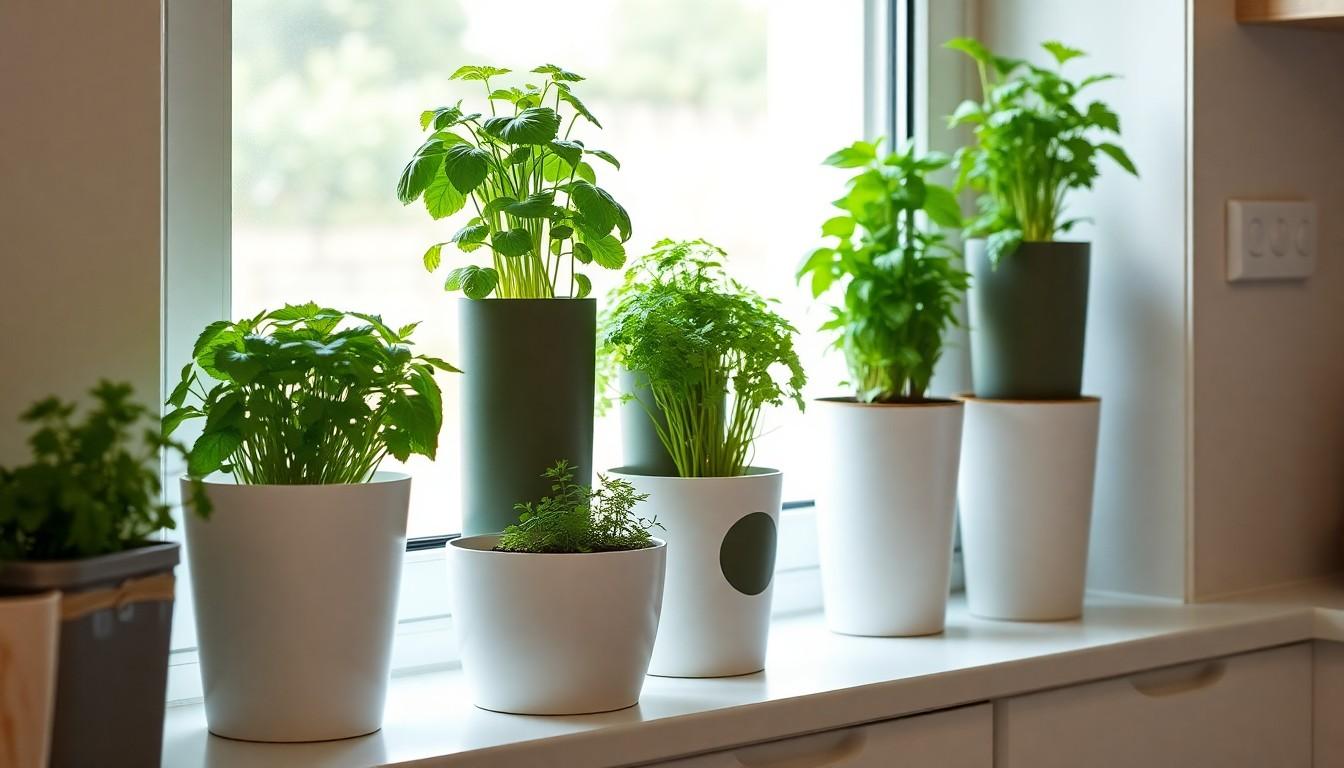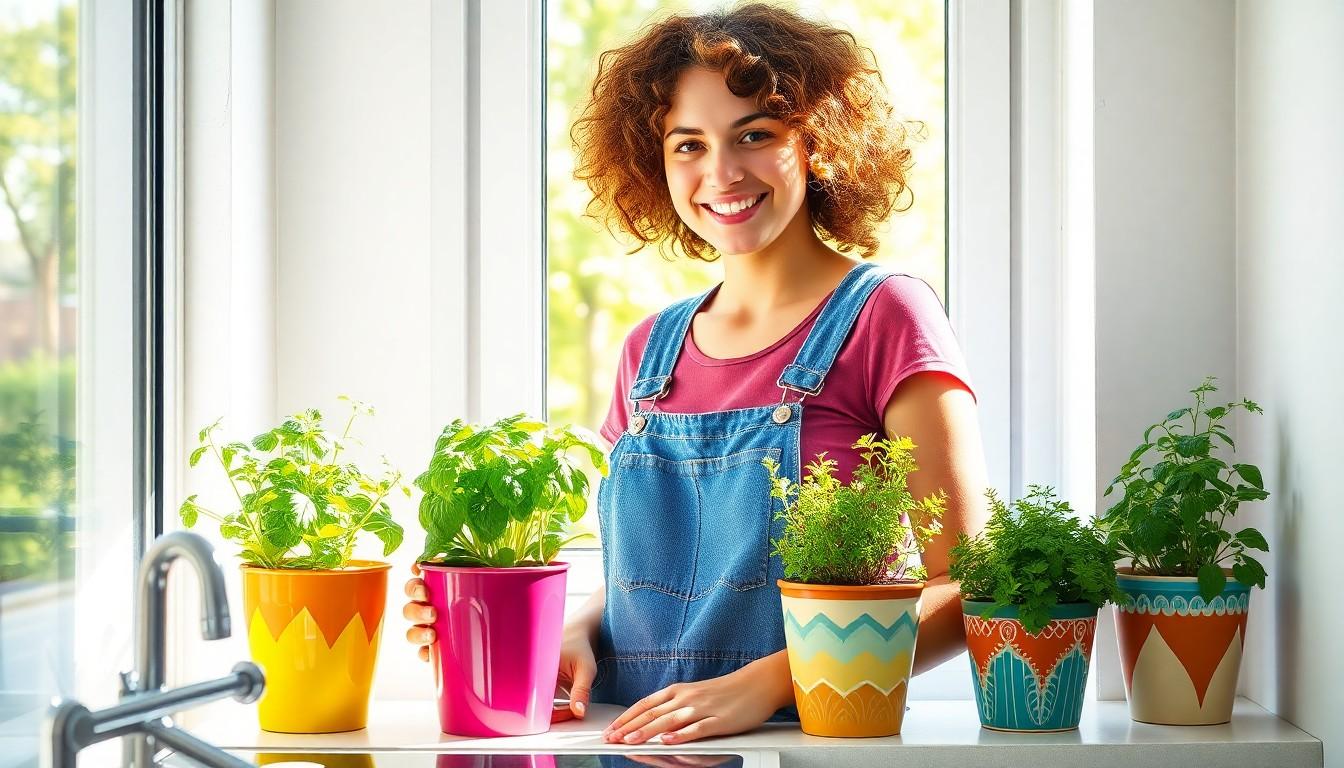Imagine stepping into your kitchen and being greeted by the fresh aroma of basil, parsley, and mint, all grown right at home. With herb growing pots, this dream can become a reality, even for those with the blackest of thumbs. These charming little containers not only add a splash of greenery but also invite a world of flavor into everyday meals.
Herb Growing Pots
Herb growing pots provide an accessible way to cultivate fresh herbs indoors. Many designs cater to various skill levels, making gardening feasible for anyone. These pots often come with drainage holes, which ensure proper water retention and prevent root rot.
Selecting the right pot size matters; generally, pots should hold at least 1-2 gallons of soil for optimal growth. Various materials like ceramic, plastic, and biodegradable options suit different preferences and styles. Each material offers unique benefits, such as durability or sustainability.
Several pots feature self-watering systems, allowing for easier maintenance and consistent hydration. Herbs commonly grown in these containers include basil, parsley, cilantro, and mint, all of which thrive in well-drained soil.
Customization options also exist, including decorative pots that enhance kitchen aesthetics. Many herb garden kits comprise pots that fit together, making efficient use of space. They can be placed near windows to maximize sunlight exposure.
Herb growing pots serve not only functional purposes but also add charm to kitchen environments. Their ability to produce fresh herbs leads to flavorful meals while encouraging healthy cooking practices. The trend of indoor gardening continues to grow, supported by these innovative pots that foster a convenient way to enjoy homegrown herbs.
Benefits of Using Herb Growing Pots

Herb growing pots provide numerous advantages for cultivating fresh herbs indoors. These benefits support home cooks and gardening enthusiasts alike.
Space Efficiency
Cultivating herbs in pots maximizes limited space. Compact designs fit on windowsills, countertops, or small balcony areas. Vertical arrangements allow various pots to stack, creating more growing opportunities in tighter spots. Herb pots require minimal square footage compared to traditional garden beds. Smaller sizes facilitate easy mobility, letting individuals move herbs indoors or outdoors as needed. Choosing the right size can also optimize airflow and light exposure, further improving growth even in smaller living spaces.
Enhanced Growth Conditions
Herb growing pots foster ideal growth conditions for herbs. Proper drainage holes prevent overwatering, essential for healthy root systems. Custom soil blends tailored for herbs offer the nutrients required for vigorous growth. Some pots incorporate self-watering features that ensure consistent moisture. Temperature regulation also plays a key role; pots can be moved to warmer or sunnier spots as needed. Certain materials, like ceramic, retain heat better, creating a conducive environment for herb growth. These tailored conditions help enhance flavor and nutrient profiles, making homegrown herbs a culinary delight.
Types of Herb Growing Pots
Herb growing pots come in various types, each catering to specific preferences and needs. These options ensure users find the ideal pot for cultivating herbs indoors.
Material Options
Ceramic pots offer durability alongside aesthetic appeal. Their attractive designs can complement kitchen décor, while their ability to retain moisture effectively benefits herb growth. Plastic pots provide a lightweight option, enabling easy movement while remaining budget-friendly. Biodegradable materials, such as coconut coir or recycled paper, promote eco-friendly practices, breaking down naturally when disposed of. Additionally, metal pots, often styled in modern designs, lend a trendy touch and can withstand exposure to the elements if used outdoors. Each material provides unique advantages, allowing gardeners to choose what best suits their cultivation style.
Size Variations
Sizes of herb growing pots vary significantly, accommodating different spaces and herb types. Standard options usually range from 4 to 12 inches in diameter, providing choices for novice to experienced gardeners. Smaller pots fit perfectly on kitchen windowsills or countertops, ensuring accessibility. Larger options, approximately 1 to 2 gallons, support a greater variety of herbs while providing ample space for roots to grow. Vertical planters serve as clever solutions for limited space, stacking multiple pots in a small footprint. Assessing the size needed assists in selecting the best pot for successful herb cultivation.
Choosing the Right Herb Growing Pots
Selecting suitable herb growing pots is essential for successful cultivation. Factors like location, drainage, and material significantly impact herb health and growth.
Considerations for Indoor vs. Outdoor Use
Indoor herb pots typically require compact designs that fit on windowsills or countertops. These pots benefit from self-watering systems to prevent under- or over-watering. Outdoor pots, conversely, need sturdier materials to endure various weather conditions. Choosing lightweight options enhances portability for outdoor arrangements. Consider whether herbs need shade or full sunlight, as outdoor pots can be placed in areas with ample light. Also, plan for temperature fluctuations that may affect plant growth. Whichever option is selected, ensure it meets the needs of the intended location.
Drainage and Aeration Features
Proper drainage is crucial for healthy herb growth. Pots without drainage holes can lead to overwatering and root rot. Look for pots that provide sufficient aeration to promote root development. Some pots feature built-in drainage trays to catch excess water, allowing roots to absorb moisture without remaining submerged. Various materials, including ceramics and plastics, can contribute to effective drainage. Additionally, consider pots with breathable designs that support airflow. Optimal aeration enables nutrient distribution, enhancing herb flavor and growth.
Care and Maintenance Tips
Maintaining herb growing pots requires attention to several key factors for optimal growth. Regular watering ensures herbs receive adequate moisture while preventing overwatering. Drainage holes play a vital role in this, as they allow excess water to escape, safeguarding against root rot.
Fertilizing herb plants enhances their growth. A balanced, water-soluble fertilizer promotes healthy development and gives herbs essential nutrients. Applying fertilizer every four to six weeks during the growing season typically yields robust plants.
Proper sunlight exposure significantly affects herb growth. Most herbs thrive in direct sunlight for at least six hours daily. Positioning pots near windows or utilizing grow lights helps maintain sufficient light conditions, especially in low-light areas.
Temperature regulation also matters. Herbs generally prefer temperatures between 60°F and 75°F. Ensure pots are placed away from drafts, heating vents, or air conditioning units to create a stable environment.
Pruning encourages bushier growth and enhances flavors. Regularly trimming leaves or stems not only promotes new growth but also prevents overcrowding in pots. Harvesting herbs frequently boosts flavor potency and ensures continuous growth.
Pest management is crucial for indoor herb gardens. Regularly inspecting plants for signs of common pests, like aphids or spider mites, enables quick intervention. Using organic insecticidal soap can effectively eliminate pests without harming the plants.
Cleaning pots helps maintain hygiene. Removing any dead leaves or debris prevents mold and disease. Rinsing pots periodically with warm water keeps the growing environment healthy and productive.
Rotating herb containers ensures even growth. By changing the orientation of the pots every few weeks, plants receive uniform light exposure. This practice fosters balanced growth and reduces the risk of leggy plants.
Following these care and maintenance tips will lead to thriving herbs that enhance culinary experiences.
Flavorful Journey in Indoor Gardening
Herb growing pots provide an excellent solution for anyone looking to enhance their culinary experience with fresh herbs. Their versatility and ease of use make them ideal for both novice and experienced gardeners. By choosing the right pot and following essential care tips, individuals can enjoy a bountiful supply of homegrown herbs year-round.
These pots not only beautify kitchens but also encourage healthier cooking habits. With various materials and designs available, there’s a perfect option for every space and preference. Embracing herb growing pots can lead to a rewarding and flavorful journey in indoor gardening.

